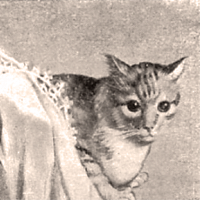-- Le Industrie Femminili Italiane, 1906

... although rescue was quick, and despite the dedicated efforts of firefighters, both the Italian and Hungarian exhibitions of the Decorative Arts were engulfed in flames. When day came, all that remained of the site was a pile of smoldering rubble and charred beams...
-- L'Illustration, 1906
In what was probably the single worst loss of needlework excellence in history, the Decorative Arts Pavilion burnt to the ground halfway through the World's Fair in Milan in 1906.

An unpardonable act of arson. The list of pieces submitted to the Fair for display and for sale is a dozen pages long: furnishings – entire bedroom suites, dining room linens, door hangings and curtains, window treatments and coverings; clothing – traditional costumes, baby, children, women's and men's outfits, lingerie, personal, table and household linens; dolls wearing representative territorial costumes.

Needle lace, bobbin lace, knitting, crochet, traditional embroidery, territorial specialty embroideries and laces, tapestries, weaving – works of all materials: silk, linen, gold, straw, cotton.
Gone.
Can you imagine the horrific news reaching the women who laboured to make their very best pieces? The loss... the loss!
Much more than embroidery and lace was burned to ashes: priceless manuscripts, documents, metal statues "reduced to ingots".

Then: within 40 days – the Pavillion was reborn. They literally worked around the clock: the architects, the builders, the artists and artisans, the embroiderers, the weavers and the lacemakers to produce exhibitions every bit as wondrous as those that had been lost. Grand prize and gold medal winners.
"... Also worthy of particular praise, is the National Cooperative of Women's Industries... which managed, with really wonderful results, to awaken and discipline in the remotest provinces of Italy... traditional female industries - embroidery, lace or woven fabrics - characteristic of each region. Of these works there were some wonderful ones from Sardinia or from Friuli, the Abruzzi or Bergamo, from Valsesia or Calabria, [which were] burned in the first exhibition, and although much less numerous, there are beautiful ones in the renewed exhibition. ... Among all the other works, of special, very distinguished importance appeared and appear, however, the exquisitely delicate lace of Aemilia Ars..."
-- Vittorio Pica, L'Emporium, 1906.
Many, many thanks to the people of the Ning Group MI 1906 who have made this post possible.
I will continue my research for traces of these pieces and will post here when I find them!





What a great and sad disaster - I haven't ever heard about this!
ReplyDeleteThank you Jeanine for such precious information you give us.
As I can't find any e-mail in your blog I dare to ask you here:
Can you give me some information about Punto Rodi? I have some Italian magazines (most Rakam) and some of them show single diagramms about Rodi stitch. But I can't understand very well the stitch. How is it called in English? Is it the Single Faggot Stitch Mary Thomas shows in her dictionary?
Thanking you in advance
my best regards
méri
Hi Meri,
ReplyDeleteI'm sorry I don't have Mary Thomas' book.
Check the post for June 30th!